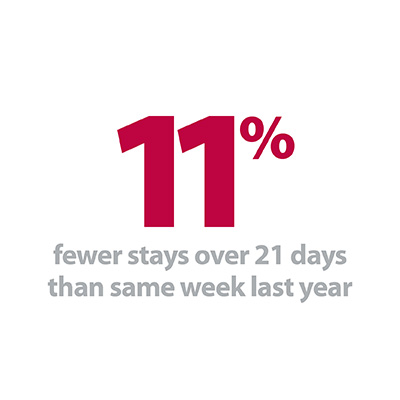


The data from the third week of the winter sitreps was held back and published at the same time as the data from week four as a result of the Christmas period.
On balance, performance during this week of the year was encouraging.
Patient flow continued to show improvement, with fewer patients experiencing long hospital stays than in previous weeks and over last winter. The continued emphasis on reducing long stay patients appears to be having the desired effect, with 4% fewer super stranded patients (those staying longer than 21 days) compared to the previous week. Perhaps one of the most striking improvements since last winter is that this represents an11% improvement than in the same week last year, or 1,807 fewer patients kept in hospital for over three weeks.
The continued emphasis on reducing long stay patients appears to be having the desired effect, with 4% fewer super stranded patients (those staying longer than 21 days) compared to the previous week.
When we look at what is happening to the number and types of beds, we also see a different story emerging from last year.
The total number of beds open is higher than the same week last year, but occupancy is trending downwards with a drop of 2.2% since last week and 3% since week one.
While total bed occupancy remains high at 91.2%, it appears under control with fewer escalation beds needed than in previous weeks and a significant reduction from the same week last year. The fact that the use of escalation beds is falling, indicates trusts are more able to meet demand, with this week seeing fewer escalation beds opened than at any point in the 2017/18 winter reporting period.
These improvements in performance are even more impressive, when set against clear evidence that demand for urgent and emergency care continues to rise. Ambulance arrivals are higher than any time this year or last, and the long-standing issues with the A&E four hour waiting target are well known. This week, an additional 506 patients arrived by ambulance each day compared to last year, despite traditional drivers of winter demand such as flu and norovirus yet to be fully felt.
The fact that the use of escalation beds is falling, indicates trusts are more able to meet demand, with this week seeing fewer escalation beds opened than at any point in the 2017/18 winter reporting period.
Here are some of the key findings from this week’s data:
- There were 99,091 ambulance arrivals this week, the highest weekly total of the year to date and higher than anything seen in 2017/18.
- Despite the increase in arrivals, handover delays are very similar to last week, and down by 3% on the same week last year.
- There were 15 A&E diverts this week, half the number seen in the previous week.
- 91.2% of general and acute beds were occupied, an improvement of 2.2% from last week, but slightly higher than the same week last year.
- The number of escalation beds open dropped by 263 since last week to 1,987. This is 18% lower than the same week last year.
- The number of long stay patients continues to fall, with 4% fewer people staying 21 days or more compared to last week, and an 11% improvement compared to the same week last year.
- Beds closed due to D&V and norovirus increased by 37% since last week to an average of 511 beds per day, but this is still far lower than at any point last year.
Overall, these positive points reflect the strong work trusts are doing to meet the challenges of winter, but must still be considered alongside the extremely high demand for urgent and emergency care.
While the solid improvements to handover delays point to a more resilient system, it remains to be seen whether it will be able to cope with any further increase in demand resulting from changing conditions in the New Year.
If you would like to see a further breakdown of the winter sitreps data, please review our summary dashboard.